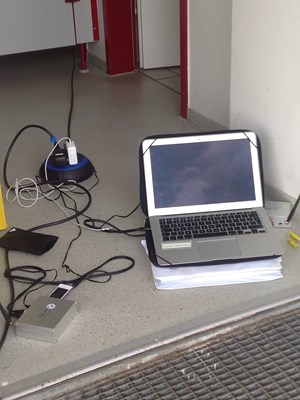Innovation and Technology
International Teacher Magazine 23-04-2016
Innovation through technology
How technology can support PHE
By Lieke Burghout-Lemmers, International School of Düsseldorf
www.physed.rocks
From Challenge to opportunity “Wireless Headphones”
Two years ago I found myself in between ”gym facilities”. The old gym was torn down and a new Sport and Community Center was being built. All PHE classes proceeded in what we called ”The Bubble”: a huge semi-permanent, inflatable tent located on the soccer pitches. There were no walls and often two classes were taught simultaneously. A single net divided The Bubble into different learning spaces. Instructing the students and keeping them focused was difficult; teaching anything using music was even more challenging for teachers and students alike.
While thinking of solutions to overcome this obstacle I suddenly remembered a documentary about a new phenomenon in Clubs and Discos. It showed how young adults would go to silent discos for the enjoyment of music and dancing.
After doing some research on the silent disco topic I was quite pleased to find out that one of the distributors of silent disco equipment had its business not too far from where I was located. The cost was also minimal. We ordered a set of 3 transmitters and 40 headphones for two classes. This solution worked brilliantly because the headphones were designed for moving and dancing. Dance, run or jump: these headphones “support” all actions. The three transmitters can broadcast over three channels and the headphones can be switched between these channels. When students wear their headphones they are more drawn into listening and less triggered into talking, leading to a more focused learning environment.
I have used the silent disco equipment in multiple settings. For example:
Students receiving instruction from a screen (videos).
Students receiving instruction from fitness Apps.
Injured students can individually perform a workout following instruction from fitness YouTube channels.
Group work: when designing dances or performances four groups can use their own music without getting distracted by the music of others. (three with headphones and one group just using the surround system)
Differentiated learning: For example students can choose their stage of running development and practice their endurance following different episodes of the National Health Service England podcast “From couch to 5k”. The students were able to choose from three levels of difficulties. It was interesting to see how none of the students looked at other students and complained that it was unfair that some were allowed to walk/jog while others were asked to jog/run/sprint. They had autonomy over their own learning. The reach of the silent disco is about 100 meter.
Momentarily I am looking into the possibility of combining the silent disco headphones with a microphone. Students would be able to receive more individualized instructions from me (or others) while listening to the general instructions. While they are practicing their endurance I could give feedback about their running form, without having to shout across a soccer pitch. Or when they are playing games I could create three channels for the different positions used in invasion games. Peer coaches could give each other instructions during a game. Or I could create a “help line” for the referees such as the TMO in rugby. The possibilities are endless.
Students as innovators of learning “The use of Quadcopters in PHE”
Not too long ago I assigned my 9th grade students with a task to plan, create, perform and produce a video clip. The task covered three different assessment criteria for MYP. Students received ample time to design their performance during class. However I did emphazise that the recording of this production should be done outside the physical environment of the Sport and Community Center. I wanted the students to really think about the setting of their video clip and how this could play a role in communicating their performance to their audience.
Overall the work done by the students was creative and interesting to watch; however one group caught my immediate attention. When looking at this video it took me a short amount of time to realize that the recording of this was done through the use of a quadcopter (aka a drone). The students took the concept “levels” very literally and showed their performance from different levels to their audience. Their final product was received with such an enthusiasm that I took immediate action to ask parental and student permission to share this work with a wider audience. I have shared it on YouTube, Twitter, and other social media platforms. By sharing this globally I allow for the students to receive authentic feedback from other PHE teachers from around the world. The feedback received will be collated and shared with them. The reasoning is that I want to show my students that their work matters outside the Sport and Community Center.
The video clip has created a little unexpected wave. PE teachers who were planning the request to buy quadcopters now were able to show their budget holders how this benefits the learning of their students. When performing or playing games, a bird’s eye view gives a great perspective to the students to view their performances more effectively, leading to improved self evaluation.
Student work (https://youtu.be/f8ZFH5QR-e8)
Article International Teacher Magazine 2015 (http://consiliumeducation.com/itm/2015/11/25/innovation-technology-supporting-phe-physical-and-health-education/)
 IMG_1022
IMG_1022